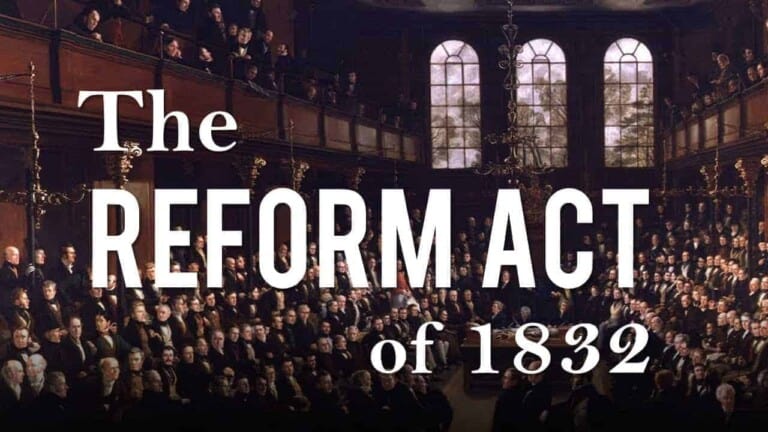Before 1832, the electoral system in Great Britain was confused: there were County seats, Borough seats, “scot and lot” seats (where any adult male who paid local poor rates could vote), “potwalloper” seats (where every resident male of at least 6 months standing who was not a pauper could vote) and of course “rotten boroughs”.
Eventually, after a long struggle (cf The Peterloo Massacre in 1819), the First Reform Act was passed by a Whig Government in 1832, which resulted in an extension of male suffrage for England: in county seats to those owning freehold property worth at least 40 shillings per annum and those leasing or renting land worth at least £50 per annum; in borough seats to those owning property worth at least £10 per annum with provisions.
There were also changes in the distribution of seats: 56 borough constituencies lost their representation entirely, 30 boroughs lost one of their two members, 22 new Parliamentary boroughs were created with two members, 19 new Parliamentary boroughs were created with one member and county representation increased. Similar measures affected Wales, Ireland, and Scotland.
However, many working-class men felt they had gained nothing from this legislation: they only saw a small increase in the electorate to the advantage of the middle class. There followed a period of agitation, referred to as Chartism.
In 1835, there were calls for the repeal of Stamp Duties, for an honest and cheap press. The London Working Men’s Association, with middle-class participation, organised a petition composed of Six Points, published in 1838 as the People’s Charter.
They wanted:
- A vote for every man aged 21 or over
- A secret ballot
- No property qualification for MPs
- Payment of MPs
- Equal constituencies
- Annual parliaments
Chartism ebbed and flowed over the next 20 years with a peak in 1848. Fervour often coincided with economic and social problems (bad harvests, unemployment, strikes, famines).
Some say Chartism failed because the working class was not ready for the vote; others that the Chartists were riven by internal divisions and Governments certainly always fought hard against them, branding them as evil wreckers. After 1858, Chartism faded away.
During the 1850s, there were numerous limited reform proposals, most of which emanated from Lord Russell, but Parliament was not ready yet for them.
In 1866, Gladstone drafted a Reform Bill which was defeated by a coalition of right-wing Whigs and Conservatives. The Government fell. Thus followed a wave of popular resentment: extra-parliamentary pressure led to another attempt at reform, this time proposed by the Conservatives under Lord Derby and Disraeli.
Eventually, the Second Reform Act was passed in 1867, a “leap in the dark” according to Derby. A new concept was initiated called “household suffrage with safeguards”, though the safeguards were soon to be dropped.
In the boroughs, residential qualification was one year, and £10 annual rent lodgers were accepted. In the counties, the annual rent qualification was fixed at £12 per annum.
Altogether this led to the enfranchisement of 1 250 000 men of the “upper” working class, a fine reward according to Disraeli.
Some measures required a few years to come to fruition. It took 6 years until all miners in rent-free colliery homes in Morpeth could vote for example. Some feared this would lead to the rise of socialism. Others believed that no individual had a “right” to vote. The working class was variously described as “venal and ignorant”.
After the enfranchisement of urban householders in 1867, the next step was to do the same for rural householders. The spread of literacy removed one objection. The Whig influence was declining. The Liberal Joseph Chamberlain pushed hard for reform.
Eventually, Gladstone’s Liberal Government pushed through the 3rd Reform Act in 1885. Single-member constituencies were imposed in counties and most boroughs. The chief victims were the Whigs, who had often been paired with Liberals.
The electorate increased from 2.5m to 5m in England and Wales (2/3 of men could vote). Yet men in receipt of poor relief were still disenfranchised, there was a one-year residence qualification and women were still voiceless.
Synopsis » Inequalities in Great Britain in the 19th and 20th centuries
- Ante Bellum, Inter Bella : Legislation and the Depression
- Electoral inequalities in Victorian England: the Road to Male Suffrage
- Inequalities in Britain today
- Inequality and Gender
- Inequality and Race
- More electoral inequalities : the Road to Female Suffrage
- The Affluent Society : poverty rediscovered?
- The Beveridge Report: a Revolution?
- The Poor Law Amendment Act (1834)
- The Thatcher Years : the individual and society
- The Welfare State: an end to poverty and inequality ?
- Victorian philanthropy in 19th century England
